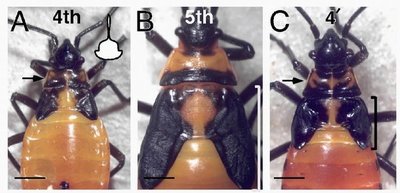May 4, 2006
More about metamorphosis: Researchers study gene that aids maturation
It is a marvel of nature that a creature such as a caterpillar changes into something quite different, a butterfly. Contrast that with a grasshopper, which looks largely the same from the time it hatches through its adult stage.
New research at the UW shows that a regulatory gene named broad, known to be necessary for development of insects that undergo complete metamorphosis, also is key for the maturation of insects that have incomplete metamorphosis. The work appears to present the first molecular evidence that the nymphal stage in lower insects is equivalent to the pupal, or chrysalis, stage of advanced insects such as butterflies.
Metamorphosis evolved in insects about 300 million years ago from ancestors of direct-developing insects such as grasshoppers. Biologists know the broad gene regulates metamorphosis in flies and moths and is found only at the transition between their larval and pupal stages. To understand how metamorphosis evolved in insects, the UW researchers examined how the broad gene functions in direct-developing insects, which don’t have a pupal stage.
“We found that it is expressed throughout the nymphal stages, and that it is also required for change,” said Deniz Erezyilmaz, a UW biology research associate. “So it looks like metamorphosis evolved in insects by restricting the expression of the broad gene to a short but intense period of change at the transition from larva to pupa.”
Normally an insect like the grasshopper that does not undergo complete metamorphosis goes through subtle physical changes during each of its nymphal stages as it progresses to adulthood. If broad is suppressed, the nymph simply repeats the appearance from its previous phase but continues to show normal growth, Erezyilmaz said. The organism eventually becomes an adult, but adult structures such as the wings are severely undersized.
“Broad is not required to transform into the adult, but it is needed to move through the series of nymphal stages,” she said. “An insect should look different from one stage to the next, but if you remove broad it doesn’t.”
Erezyilmaz is the lead author of a paper describing the findings, published last week in the Proceedings of the National Academy of Sciences. The work was done in the UW laboratories of biology professors James Truman and Lynn Riddiford, who are co-authors of the paper, and was underwritten by grants from the National Science Foundation and the National Institutes of Health.
Genes regulate how an organism grows and changes physically as it develops. The broad gene encodes a protein that attaches itself to a specific region of a DNA chain and controls which other genes will be copied. The researchers suspect that broad must be present for the physical changes contained in those areas of DNA to be expressed. Suppressing broad prevents the changes from occurring.
“Humans don’t have the broad gene, but if they did and you suppressed it you’d have a baby that might grow to 6 feet tall but would still have the body proportions of a baby,” Truman said. “It would still have the large head and the stubby legs.”
A substance called juvenile hormone is present at each step of nymph development in insects that do not experience complete metamorphosis, and the researchers found that juvenile hormone correlates with the expression of the broad gene during the nymphal stage. Juvenile hormone disappears in the last nymphal stage and the broad gene is no longer expressed, allowing the insect to make the final transition to adulthood.
“This is the first time that anyone has seen the broad gene appear in the development of insects having incomplete metamorphosis,” said Riddiford. “It appears in the late embryonic stage and stays throughout nymphal life, then disappears when the insect transforms to an adult.”

